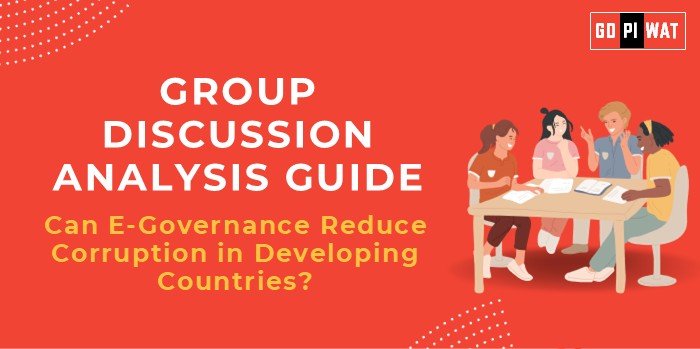📋 Group Discussion Analysis Guide
Topic: Can E-Governance Reduce Corruption in Developing Countries?
🌟 Introduction to the Topic
Corruption remains a significant hurdle in developing countries, eroding public trust, hampering economic development, and perpetuating inequality. E-governance, leveraging digital tools for transparency and efficiency, has emerged as a potential game-changer.
Rooted in digital transformation, e-governance promises to mitigate corruption by streamlining public service delivery and increasing accountability. Successful implementations in countries like Estonia and India have demonstrated its potential to reduce fraud, bribery, and bureaucratic inefficiencies.
📊 Quick Facts and Key Statistics
- 🌍 Global E-Governance Ranking: Estonia ranks 1st, while India is 107th in the UN E-Government Development Index, reflecting disparities in adoption and success.
- 💰 Direct Benefit Transfers in India: Over ₹2.7 lakh crore saved by eliminating middlemen through digital platforms.
- 📡 Internet Penetration: Developing countries average 43% internet penetration, hindering e-governance accessibility.
👥 Stakeholders and Their Roles
- 📜 Governments: Policy creation, infrastructure development, and enforcement of anti-corruption measures.
- 🏢 Private Sector: Providing technical solutions and innovations for scalable e-governance platforms.
- 🌍 International Organizations: Advocacy, funding, and knowledge sharing (e.g., World Bank’s Digital Governance programs).
- 👩👩👦👦 Citizens: Acting as participants and beneficiaries of transparent systems.
✅ Achievements and Challenges
🏆 Achievements:
- 🇪🇪 Estonia: Reduced public corruption with a 99% digital public service model.
- 🇮🇳 India: Saved ₹2.7 lakh crore via digital payments and DBTs.
- 👁️🗨️ Transparency: Digital platforms ensure audit trails, reducing bribery opportunities.
⚠️ Challenges:
- 🌐 Digital Divide: Only 20% of rural households in India have stable internet access.
- 🔒 Cybersecurity Risks: AIIMS ransomware attack exposed vulnerabilities in digital infrastructures.
- ⏳ Resistance to Change: Bureaucratic inertia and public skepticism slow adoption.
🌍 Global Comparisons
- 🇸🇬 Singapore: Combines robust e-governance with strong legal frameworks to curb corruption.
- 🇮🇳 India: Struggles with inconsistent implementation across states.
📌 Structured Arguments for Discussion
- 🔹 Supporting Stance: “E-governance drastically reduces corruption by minimizing human interaction in public service delivery, as seen in Direct Benefit Transfers in India.”
- 🔹 Opposing Stance: “Without addressing the digital divide and cybersecurity, e-governance risks further exclusion and corruption via digital manipulation.”
- 🔹 Balanced Perspective: “E-governance can reduce corruption, but its success hinges on robust infrastructure, equitable access, and security measures.”
🔍 Effective Discussion Approaches
- 📈 Opening Approaches:
- “According to Transparency International, digital governance could reduce bribery by up to 50%, a transformative figure for developing countries.”
- “The $10 million savings from Kenya’s e-procurement system shows how technology can combat corruption at scale.”
- 🔄 Counter-Argument Handling:
- “While cybersecurity risks exist, investment in training and resilient systems can mitigate such challenges, as seen in Estonia’s approach.”
📈 Strategic Analysis of Strengths and Weaknesses
- ✅ Strengths: Transparency and audit trails, reduction in physical paperwork.
- ⚠️ Weaknesses: Cyber vulnerabilities, resistance from traditional bureaucracies.
- 🌟 Opportunities: Expansion of internet access, global collaboration for scalable models.
- ⚡ Threats: Digital exclusion, risk of algorithmic bias.
🎓 Connecting with B-School Applications
- 💡 Real-World Applications: Projects on digital finance platforms or corruption-resistant procurement systems.
- 💬 Sample Interview Questions:
- “What measures would you suggest to ensure cybersecurity in e-governance?”
- “How can e-governance drive inclusivity in developing countries?”
- 📘 Insights for B-School Students: Focus on integrating technology with governance for maximum societal impact.


